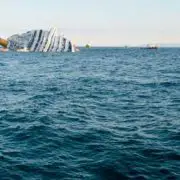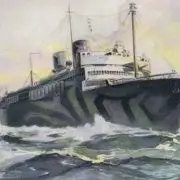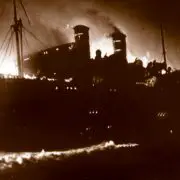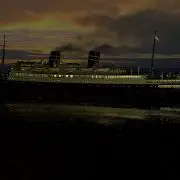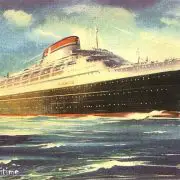Morro Castle, Mohawk and the end of the Ward Line : Part 3
12. A Family Torn Apart
Mary Lione, of Sunnyside, Queens, was carried off of the Monarch of Bermuda on a stretcher, suffering from immersion, burns and deep shock. A harrowing photograph of the injured woman, in close up profile was widely run in the press following the disaster: Mrs. Lione probably never saw it; she was in the hospital, recovering, and coping with the loss of half of her family during the days when it ran.
69 years after the fire, Anthony Cunningham and I found Robert Lione, Mary’s younger son, still living in the New York area and one of the final Morro Castle survivors. The Lione family graciously shared their information with Anthony for his book: Robert, who was 4 at the time of the fire, remembers little of the event other than hanging on the end of the rope by which he was lowered from the ship, but sent this moving clipping from 1934 which tells the story of the destruction of his family:
DEATH TAKES HALF OF FAMILYShip Fire Victims’ Coffins Tragic Anniversary FinaleTwo flower-bedecked coffins side by side in the living room of their home in Sunnyside Queens yesterday were the mute finale to a joyous wedding anniversary that ended in the flaming ruins of the Morro Castle. For ten years, Anthony and Mary Lione had worked hard to maintain their home and bring up two husky boys. They decided to take a vacation: they and the children, Raymond,9, and Robert, 4. Two of them came back from that trip – Bobby who still prattles innocently at the home of a relative, unmindful of the tragedy, and the mother, suffering the pain of a flame seared body at Flower Hospital, and the deeper anguish of her double loss. Her husband and other son will be buried tomorrow. Mrs. Lione’s story vividly caught the horror of it all.“We rose at the sounds of alarm’ she said. “I did not stop to dress, but clothed the two boys. We were on deck about an hour and a half. Then I saw my husband and Raymond lowered over the side. They let Bobby down next, and I lost sight of him until we were carried aboard the Monarch of Bermuda. The last the mother heard of any of them was the voice of Raymond crying as he went over the side. “They’ve got to save me! I don’t want to die!” But his body was one of those taken ashore at Sea Girt. He was to have entered school yesterday as a fourth grade student.
His father, Anthony, 34, a year older than his wife, was a salesman in the Jamaica office of an insurance company. He had been an architect and previous to that an orchestra leader. The two will be buried in Calvary Cemetery tomorrow, following a mass in St. Teresa’s Church where Lione was an usher.
|
Robert Lione recalls that the trip was his father’s reward for being named “Salesman of the Year.” He also opines that his father, a strong swimmer, may have been drowned by others clinging to him.
Raymond Lione’s death was later described by Frank Dittman, 16. He gave several accounts of the disaster to the press in 1934, and was interviewed by Hal Burton decades later. Although there are minor differences between his various accounts, the details remain consistent:
I was returning home on the Morro Castle from a summer of exploring craters in Guatemala and Mexico.
I was asleep in my stateroom on “C” Deck when somebody shook me. I woke up and smelled smoke and saw flames out of the porthole. I looked at my watch, and it was then 3:40 a.m. Saturday.
I put on my lifebelt immediately and went out on deck, going to the back of the boat. I tried to get to “D” Deck but the companionway was in flames and I could not make it.
Before I got very far toward the back of the boat a woman stopped me. She said she didn’t have a life preserver and she asked me for mine. Well, I gave it to her just to do something for the cause.
When I got to the starboard side I saw a lifeboat being lowered. I saw it was filled with crew members and there was not a single passenger in it. I though this was unusual, for I had been taught the crew was supposed to worry first about the passengers.
I couldn’t see anything except confusion. Nobody seemed to know what they wanted to do. A boy about 12 years old- he said his name was Raymond- came up to me and asked me to hold on to his hand. He couldn’t find his father.
The flames were getting so bad we couldn’t stand it any longer and so I just took the boy in my arms and we dived overboard.
I told Raymond to hang on to my back and I swam without a life preserver. Then a corpse floated by and I took the life preserver off it and put it on, but I had a tough time of it because the boy was still with me.
We drifted toward shore. I swam for seven hours – maybe six and a half- with Raymond on my back. Once he went to sleep and slipped off, and to bring him to consciousness again I almost bit his ear off.
We drifted into a crowd. Maybe twelve. And we all prayed there in the water. An aged woman, maybe 60, was the liveliest one of the lot. I would say she was pretty much all right. She was advising everybody what to do; how to keep their heads up.
A lifeboat with not many people in it went past us. They didn’t give us a tumble. Then another lifeboat came along when we were near shore. There were five live ones and five corpses in the boat. Somebody took the boy, Raymond, off my back and put him in the boat. Then a big wave hit the boat, and Raymond fell and smashed his head against the bottom of the boat. He was unconscious and may be dead.
When the boat landed on the Jersey Coast, I tried to find Raymond and take care of him. But there were police around and doctors and they forced me into an ambulance and took me to a hospital.
I wish I knew where Raymond was and if he is alive. He was the kind of kid it is easy to get attached to.
Frank Dittman was a cadet at the Taft School. He was widely hailed as one of the few outstanding heroes of the disaster, and was officially honored by the school later in 1934. The detail of his finding Raymond Lione aft on C Deck does not jibe with Mrs. Lione’s account of lowering him overboard. A second account, not written by Dittman, does correspond with Mrs. Lione’s story. The details coordinate with the above account except that the author quoted Dittman as saying that he first encountered Raymond Lione in the water about 100 feet from the ship. The probable cause for the discrepancy in the otherwise identical accounts is that Frank probably forgot, in the first case, to tell where and when he met Raymond and an editor created a believable meeting for the two to keep the narrative flow intact.
Mary Lione died in March 1970. She was buried in Calvary Cemetery with Anthony and Raymond. Anthony Lione was recorded as Andrew Lione in the cemetery records- whether that was a transcription error in 1934 or his real first name remains to be determined.


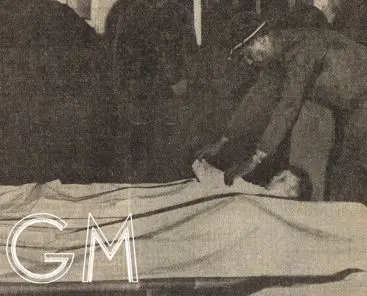
 Meanwhile, the bodies lay together at home, lights from candles in front of the crucifixes flickering on the faces of the father and of Raymond, the boy who did not want to die.
Meanwhile, the bodies lay together at home, lights from candles in front of the crucifixes flickering on the faces of the father and of Raymond, the boy who did not want to die.
